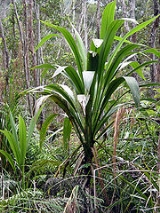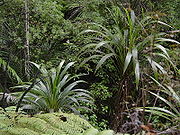
Cordyline banksii
Encyclopedia
Cordyline banksii is a monocot
tree endemic to New Zealand
. The species name banksii refers to the 18th-century botanist Joseph Banks
.
 Cordyline banksii tolerates a wide variety of habitats. It is common in coastal, lowland, and lower montane forests in the North Island
Cordyline banksii tolerates a wide variety of habitats. It is common in coastal, lowland, and lower montane forests in the North Island
, widespread in the northern half of the South Island
and Westland
as far south as Haast
. It has occasionally been reported from coastal Fiordland
, but these sightings are unsubstantiated. It also occasionally occurs in subalpine regions in the South Island. In shrublands it occurs with Cordyline pumilio
and may form hybrids with it.
Phytoplasma australiense
.
Monocotyledon
Monocotyledons, also known as monocots, are one of two major groups of flowering plants that are traditionally recognized, the other being dicotyledons, or dicots. Monocot seedlings typically have one cotyledon , in contrast to the two cotyledons typical of dicots...
tree endemic to New Zealand
New Zealand
New Zealand is an island country in the south-western Pacific Ocean comprising two main landmasses and numerous smaller islands. The country is situated some east of Australia across the Tasman Sea, and roughly south of the Pacific island nations of New Caledonia, Fiji, and Tonga...
. The species name banksii refers to the 18th-century botanist Joseph Banks
Joseph Banks
Sir Joseph Banks, 1st Baronet, GCB, PRS was an English naturalist, botanist and patron of the natural sciences. He took part in Captain James Cook's first great voyage . Banks is credited with the introduction to the Western world of eucalyptus, acacia, mimosa and the genus named after him,...
.
Distribution

North Island
The North Island is one of the two main islands of New Zealand, separated from the much less populous South Island by Cook Strait. The island is in area, making it the world's 14th-largest island...
, widespread in the northern half of the South Island
South Island
The South Island is the larger of the two major islands of New Zealand, the other being the more populous North Island. It is bordered to the north by Cook Strait, to the west by the Tasman Sea, to the south and east by the Pacific Ocean...
and Westland
Westland District
Westland District is a territorial authority on the west coast of New Zealand's South Island. Its population is - Government :The Westland District is governed by an elected Council, headed by an elected Mayor. The Mayor is elected at large. The current Mayor is Maureen Pugh. Councillors are...
as far south as Haast
Haast, New Zealand
Haast is an area in the Westland District territorial authority on the west coast of New Zealand's South Island. The Haast region covers over ....
. It has occasionally been reported from coastal Fiordland
Fiordland
Fiordland is a geographic region of New Zealand that is situated on the south-western corner of the South Island, comprising the western-most third of Southland. Most of Fiordland is dominated by the steep sides of the snow-capped Southern Alps, deep lakes and its ocean-flooded, steep western valleys...
, but these sightings are unsubstantiated. It also occasionally occurs in subalpine regions in the South Island. In shrublands it occurs with Cordyline pumilio
Cordyline pumilio
Cordyline pumilio, commonly known as the Dwarf cabbage tree, Pygmy cabbage tree or by its Māori names Tī koraha or Tī rauriki, is a narrow-leaved monocot shrub endemic to New Zealand. It usually grows up to 1 metre tall, although rare examples of 2 metres tall have been reported...
and may form hybrids with it.
Description
Tī ngahere is a sparingly-branched cabbage tree up to 4 m tall. The leaves are lanceolate (somewhat paddle-shaped), up to 2 metres long and from 40 to 80 mm wide. The leaves are broad in the mid portion and droop from there. A prominent flat midrib runs the whole length of the leaf. The fruiting panicle is up to 2 metres in length. The flowers are white and pleasantly perfumed. The globe-shaped fruit are up to 5 mm in diameter, and are white, bluish-white, or blue.Threats
C. banksii is not regarded as threatened. Unlike C. australis it seems to be resistant to a disease called "sudden decline", caused by the pathogenPathogen
A pathogen gignomai "I give birth to") or infectious agent — colloquially, a germ — is a microbe or microorganism such as a virus, bacterium, prion, or fungus that causes disease in its animal or plant host...
Phytoplasma australiense
Phytoplasma
Phytoplasma are specialised bacteria that are obligate parasites of plant phloem tissue and transmitting insects . They were first discovered by scientists in 1967 and were named mycoplasma-like organisms or MLOs. They cannot be cultured in vitro in cell-free media...
.

